Overview
This article delves into essential communication techniques for startup founders, highlighting the critical role effective communication plays in fostering collaboration, innovation, and productivity. By detailing various techniques—such as active listening, clear communication, empathy, and constructive feedback—it underscores their link to enhanced team dynamics and overall success in a competitive business landscape.
How can these techniques transform your startup's culture? Consider the impact of improved communication on your team's performance and morale. Embrace these strategies to navigate the challenges of the startup world and position your business for success.
Introduction
Effective communication is the lifeblood of any startup. Yet, many founders struggle to navigate the complexities of team dynamics. By mastering essential communication techniques, entrepreneurs can enhance collaboration and drive innovation and productivity within their organizations. However, the challenge lies in understanding which methods resonate with diverse teams and how to implement them effectively.
What strategies can startup founders adopt to ensure their communication fosters a thriving, engaged workplace?
Casy: Automate Task Management and Enhance Team Communication
Casy operates as an invisible project manager, seamlessly integrating with chat platforms like Slack and Telegram to automate task creation and updates. This automation significantly enhances group communication techniques by capturing essential information without manual input, allowing members to focus on their core activities. By minimizing administrative overhead, Casy boosts overall productivity, making it an indispensable tool for business founders seeking to streamline workflows.
With features such as project planning and task categorization, Casy effectively transforms discussions into actionable plans. Tasks are organized into clear categories like R&D, Bugs, and In Progress. This structured approach not only fosters improved collaboration but also enables teams to maintain their focus on innovation and development, ultimately driving success in fast-paced environments.
Consider this: 70% of healthcare organizations are actively contemplating the use of generative AI. This statistic highlights a broader trend towards automation tools like Casy among emerging companies. Additionally, Ginni Rometty emphasizes that technology will augment human abilities, aligning perfectly with Casy's mission to enhance group communication and productivity through effective communication techniques.
The case study on Casy illustrates its capability to capture key information from conversations to create tasks, showcasing its effectiveness in real-world applications. Are you ready to elevate your team's productivity with Casy? The time to act is now.
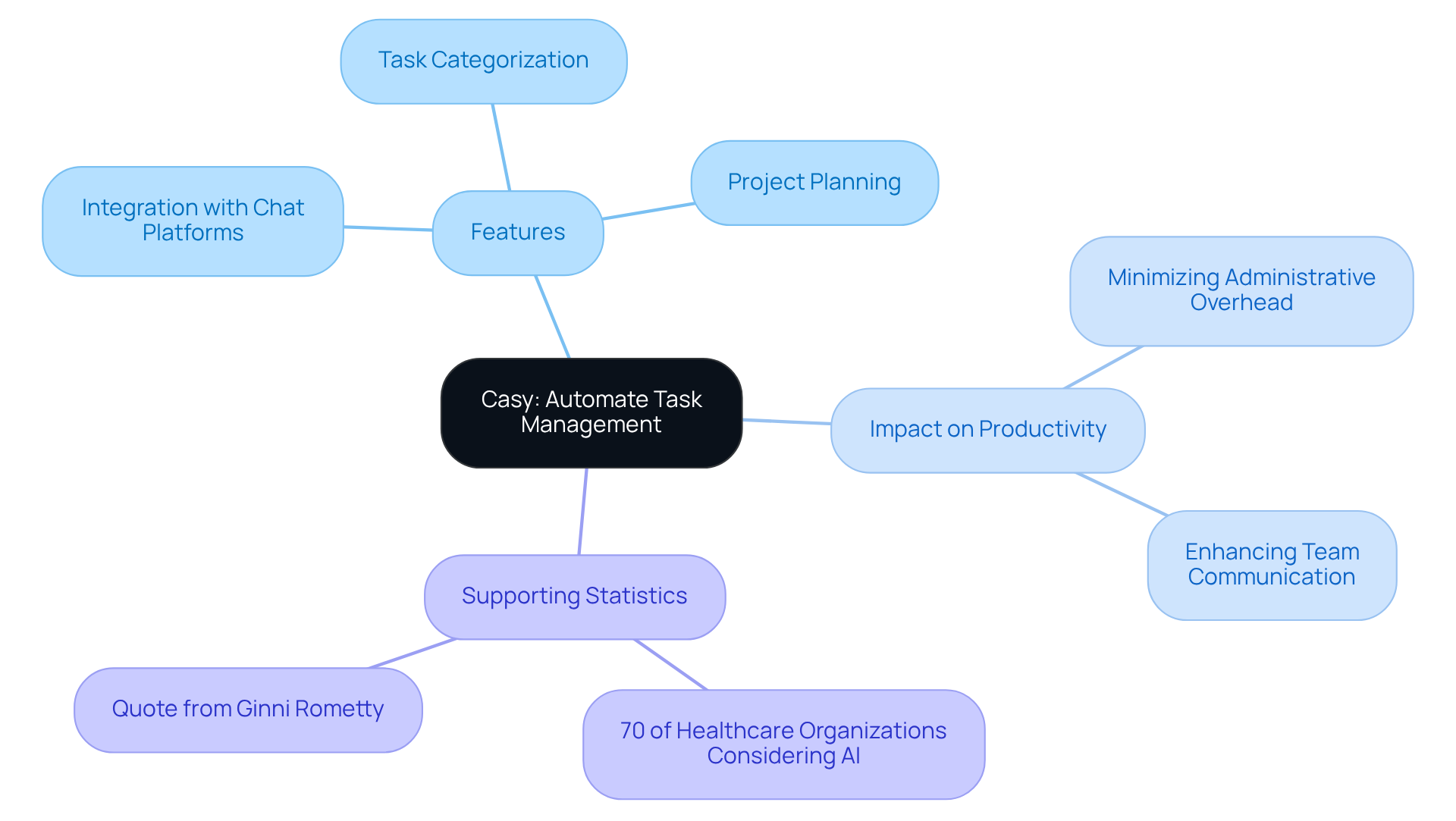
Active Listening: Foster Collaboration and Understanding
Active listening is an essential skill that requires the use of effective communication techniques to ensure full concentration on the speaker's message rather than simply hearing the words. For new business founders, this translates to employing effective communication techniques by actively engaging group members during discussions, asking clarifying questions, and reflecting on what has been expressed. Such an approach not only enhances comprehension but also fosters trust and encourages collaboration—elements that are vital for effective teamwork and innovation through the use of communication techniques.
Research shows that active listening can enhance collaboration and productivity by up to 25%, and it has been linked to an 8% improvement in sales performance. This underscores its significance for startups striving to excel in competitive markets. Furthermore, organizations that prioritize listening often experience notable advancements in innovation and problem-solving capabilities by utilizing effective communication techniques. As Heather V. MacArthur states, "Organizations that prioritize listening as a key component of their culture will often see improvements in innovation, problem-solving, and morale." A compelling case study revealed that companies employing active listening strategies reduced misunderstandings by 40%, greatly enhancing workplace efficiency.
Experts emphasize that when leaders demonstrate exceptional listening skills, they set a benchmark for their teams by fostering a culture that utilizes effective communication techniques. This is especially crucial in diverse teams, where effective communication techniques can bridge generational divides and cultural differences, thereby creating a cohesive workforce. For example, a technology firm that trained its managers in active listening reported a 30% increase in employee satisfaction, resulting in higher retention rates and a more engaged workforce. Heather V. MacArthur notes, "Managers who received training in active listening saw a 30% improvement in employee satisfaction."
In conclusion, the benefits of active listening for entrepreneurs extend beyond mere interaction; they lay the groundwork for communication techniques that foster a collaborative and innovative organizational culture, ultimately driving success. However, it is vital to acknowledge that poor listening can lead to significant challenges, as 80% of workplace complaints arise from ineffective communication. By implementing actionable communication techniques such as frequent paraphrasing and utilizing both verbal and non-verbal encouragement, entrepreneurs can refine their listening skills and cultivate a more productive work environment.
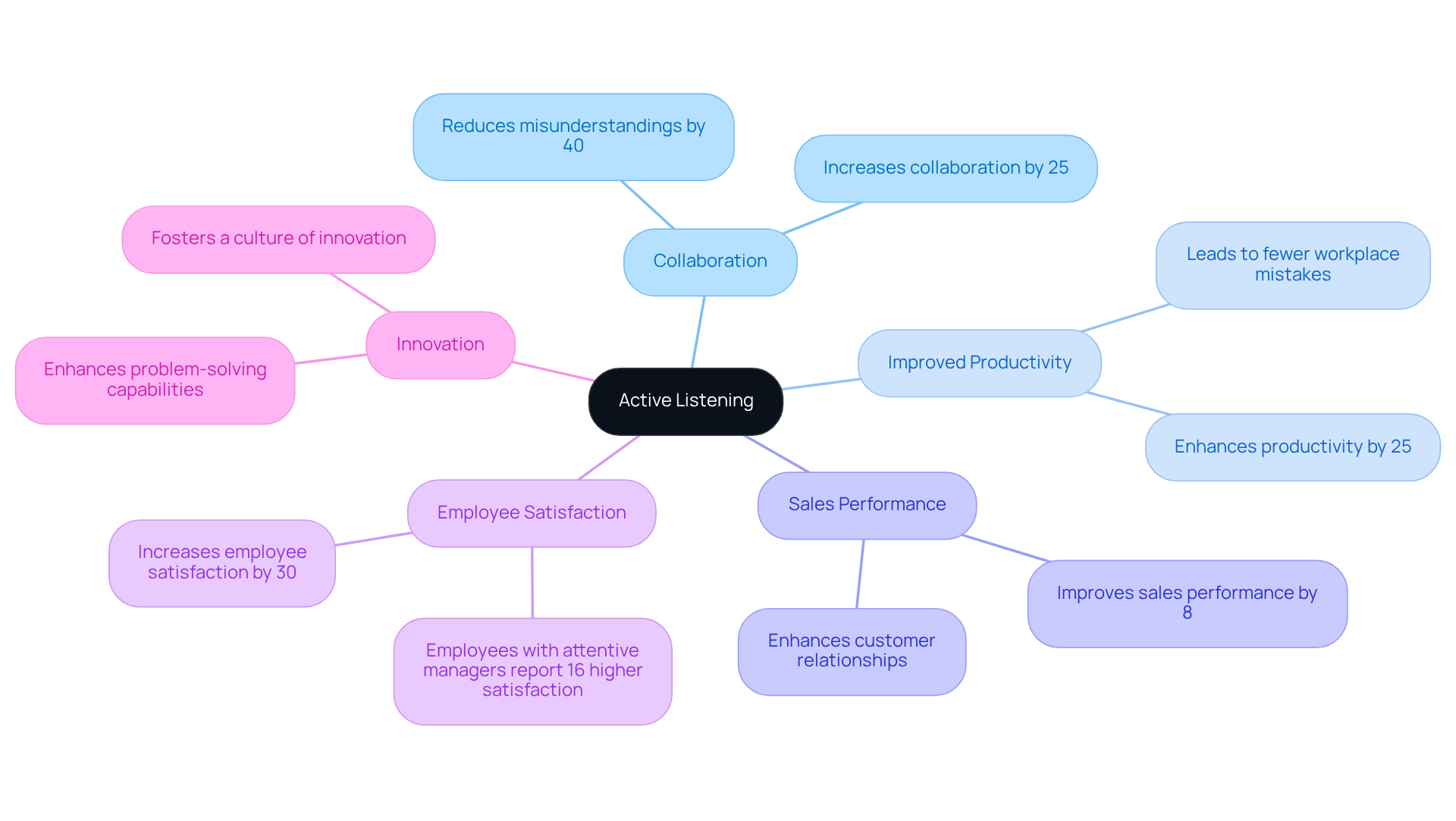
Clear and Concise Communication: Articulate Your Vision
For startup creators, employing effective communication techniques to articulate a clear and succinct vision is essential for aligning team members with the company's objectives. This clarity fosters a shared understanding and minimizes confusion, enabling teams to collaborate effectively toward a common goal. By avoiding jargon and selecting straightforward language, all participants—regardless of their background—can grasp the established objectives and expectations.
Statistics reveal that effective communication techniques can significantly enhance team alignment; 96% of individuals assert that effective exchange is vital for businesses. Furthermore, new ventures prioritizing transparent communication techniques are more likely to navigate challenges successfully, as evidenced by 35% of individuals who believe that the firms they collaborate with have improved their communication over the past year.
Experts underscore the importance of clarity in message delivery through effective communication techniques. Sven Patzer states, 'Clarity and consistency—clear and consistent communication is the foundation for successful new ventures.' Leaders are encouraged to focus on understanding their team's perspectives, which not only aids in decision-making but also strengthens the communication techniques within the organization. By fostering an environment where members feel comfortable sharing their thoughts and concerns, leaders can cultivate a culture of openness and collaboration, ultimately driving the startup toward its objectives. Additionally, leveraging tools like Casy can streamline communication processes, further enhancing team alignment and productivity.
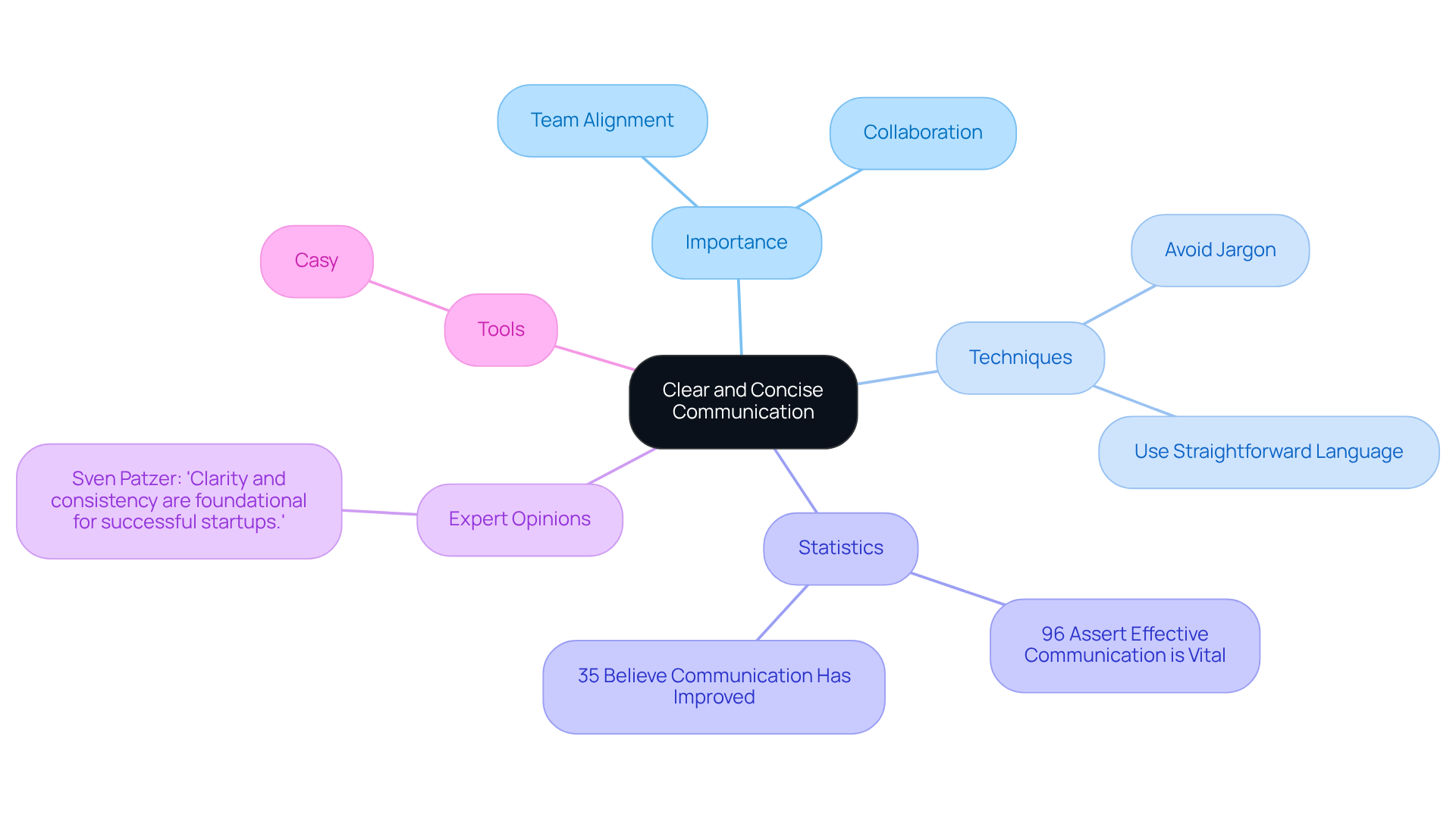
Empathy: Build Stronger Relationships with Your Team
Empathy in communication is essential for creators aiming to forge stronger relationships with their groups. By genuinely understanding and acknowledging the emotions and viewpoints of group members, founders cultivate a more inclusive and supportive work environment. This strategy not only fortifies interpersonal connections but also significantly boosts collaboration and productivity. When group members feel valued and understood, they are more inclined to share ideas and provide constructive feedback, leading to innovative solutions and improved outcomes.
Consider this: startups that emphasize empathetic leadership report a remarkable 86% of employees feeling more successful in managing their workloads. In contrast, only 13% of those lacking such leadership express similar sentiments. Furthermore, 61% of employees under empathetic leadership describe themselves as more innovative. Organizations that prioritize empathy also see lower turnover rates, with engaged teams being 59% less likely to leave.
Notably, a staggering 92% of employees believe that empathy is undervalued within their organization, underscoring the critical need for empathetic leadership. By integrating empathy into their communication techniques, founders can cultivate a thriving culture that empowers employees and drives collective success. Employees who perceive their voices as heard are 4.6 times more likely to feel empowered to excel in their roles, further highlighting the beneficial effects of empathetic communication.
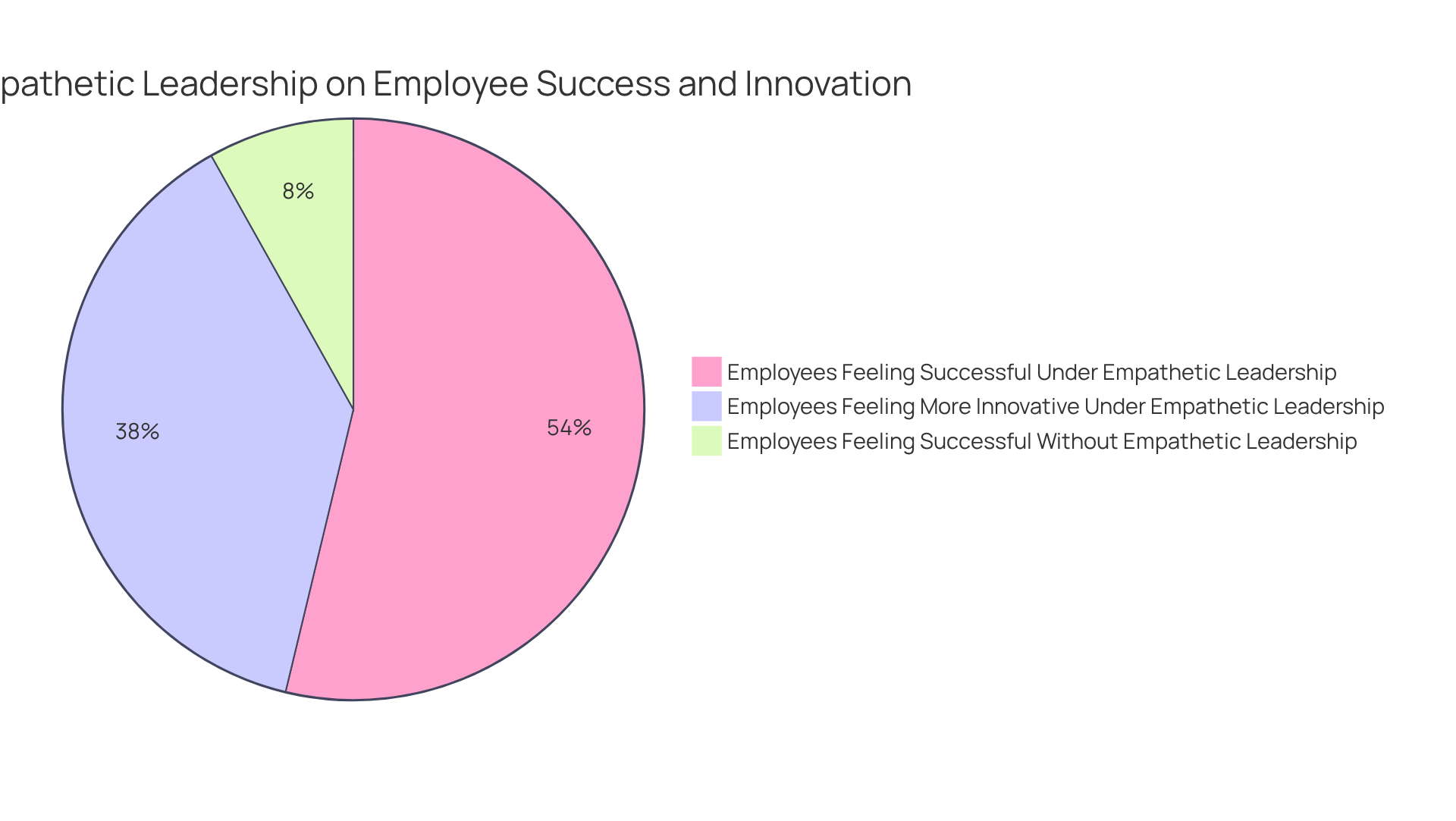
Constructive Feedback: Drive Improvement and Innovation
Constructive feedback is essential for enhancing communication techniques within the group. It should be specific, actionable, and focused on behaviors rather than personal traits. Founders need to foster an environment where feedback is not only welcomed but also seen as a valuable opportunity for growth. By consistently offering constructive feedback through effective communication techniques, organizations can significantly boost group performance, promote innovation, and uphold high work standards.
Consider this: companies that implement regular strength-based feedback can reduce turnover by 14.9% and increase productivity by 12.5%, according to Gallup's research. Furthermore, fostering a positive feedback culture through effective communication techniques is vital for driving innovation. Organizations like Google exemplify this by encouraging open communication through various platforms, resulting in numerous product improvements.
In the fast-paced world of startups, where agility and adaptability are crucial, implementing effective communication techniques to establish a robust feedback culture can be transformative. It empowers teams to pivot swiftly and innovate efficiently. By prioritizing feedback through effective communication techniques, founders can enhance employee engagement—75% of employees believe feedback is valuable for gauging performance and improving productivity. This creates a dynamic workplace that thrives on continuous improvement and innovation.
Moreover, it's important to recognize that 41% of employees have left a job because they felt unheard. This statistic underscores the necessity of cultivating a feedback culture to retain talent. Are you ready to embrace feedback as a cornerstone of your organization’s success?
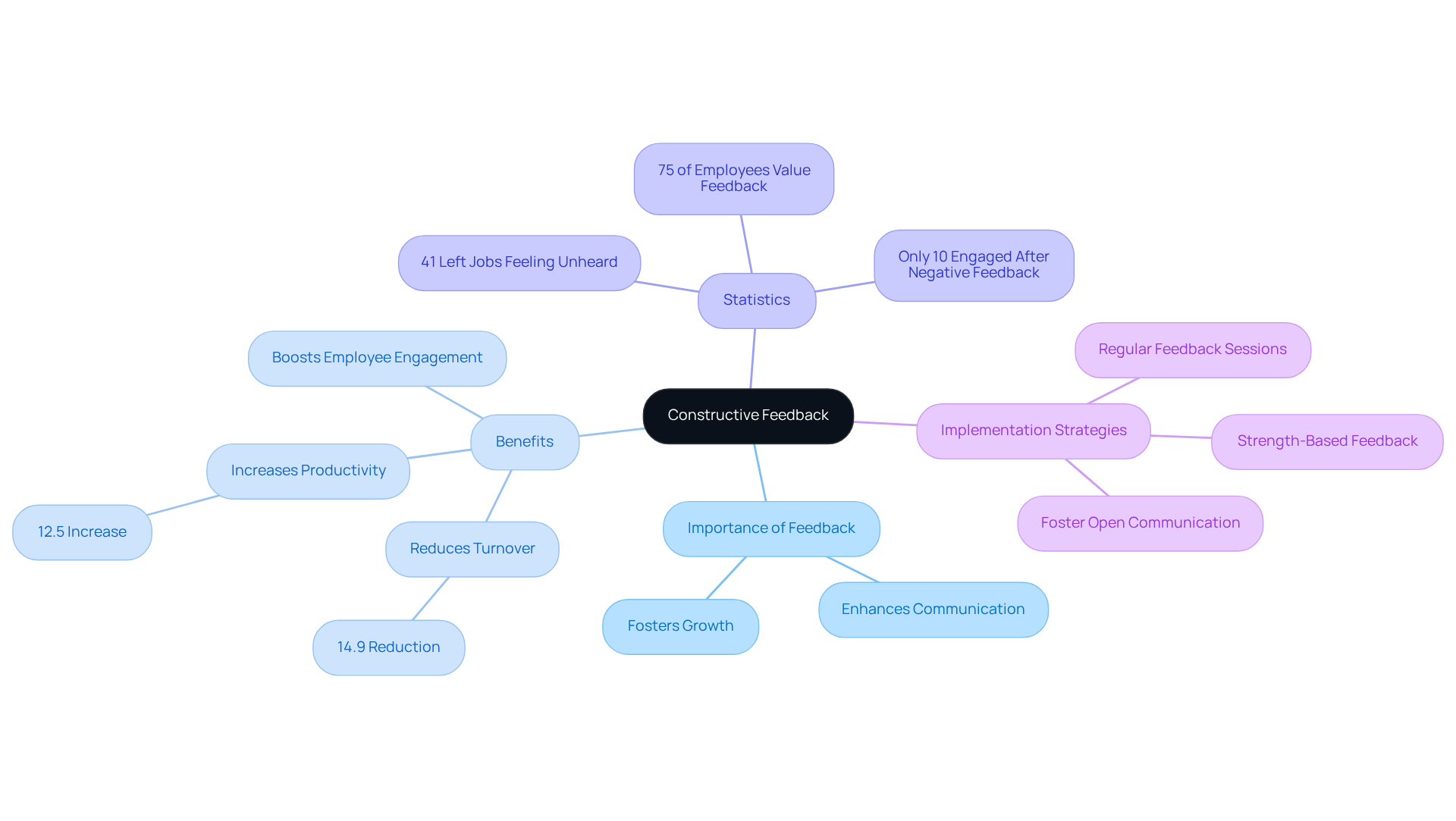
Nonverbal Communication: Understand Body Language and Signals
Nonverbal interactions encompass body language, facial expressions, and tone of voice, all of which are pivotal in shaping group dynamics. Founders must not only be aware of their own nonverbal cues but also adept at interpreting those of their team members. Research reveals that nonverbal communication constitutes 93% of the impact of any given message, underscoring its critical role in conveying emotions and intentions. Consider this: steady eye contact fosters trust and engagement, with 85% of surveyed individuals deeming it essential to business interactions. Moreover, open and expansive postures convey power and confidence, signaling approachability and assurance.
In the fast-paced environment of startups, where agility and collaboration are vital, grasping these nonverbal cues can enhance interactions and cultivate a more cohesive team environment. Statistics highlight that 55% of communication is nonverbal, emphasizing the necessity for leaders to master these skills to elevate their leadership effectiveness. Alarmingly, 22% of employees report that misunderstandings have led them to contemplate seeking new positions, illustrating the tangible consequences of ineffective communication.
By nurturing an awareness of body language and employing techniques such as maintaining eye contact for 4-5 seconds to forge an emotional connection, leaders can respond more adeptly to their group's needs. This ultimately fosters a more open and communicative atmosphere, driving productivity and innovation.
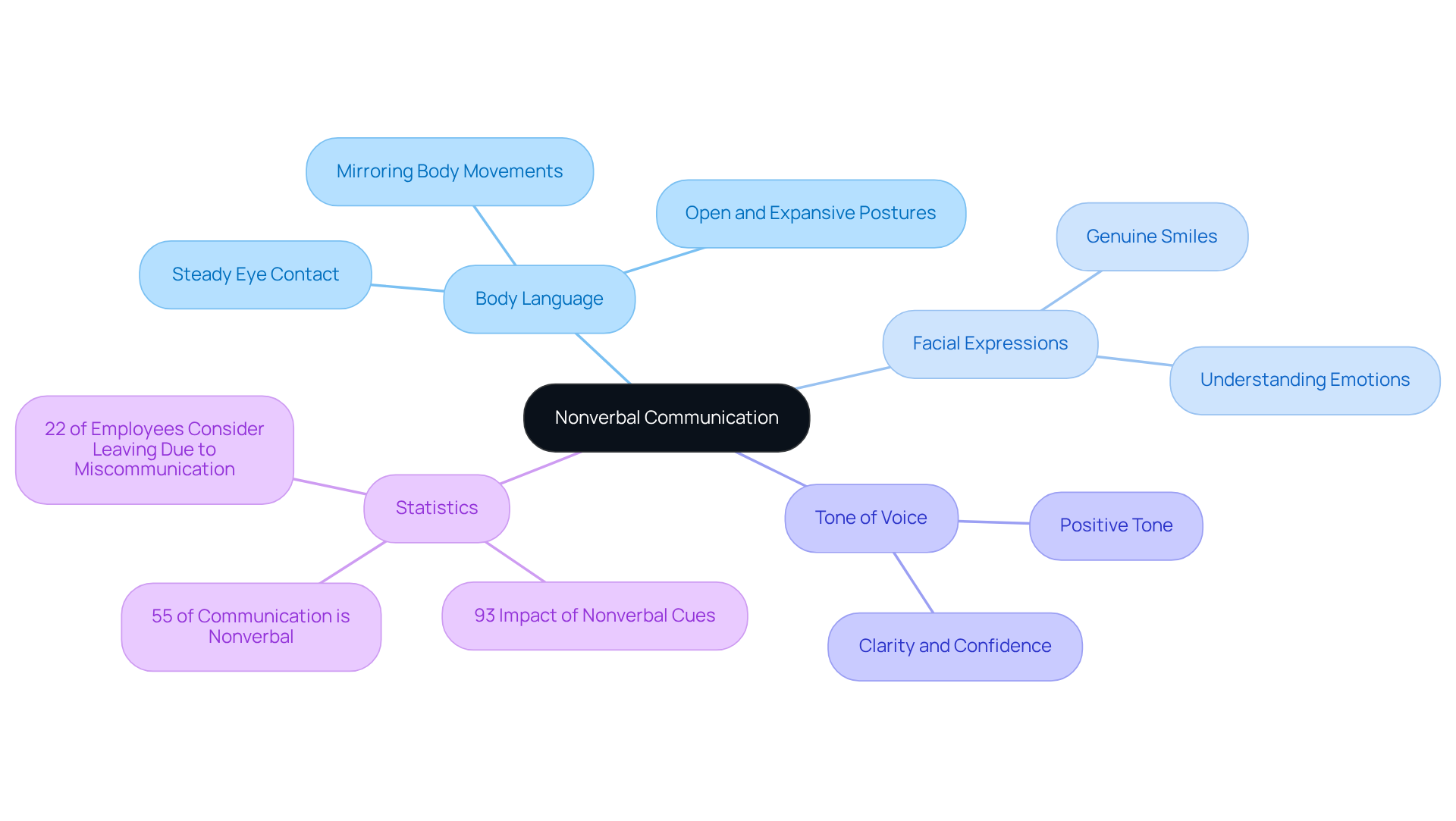
Adaptability: Tailor Your Communication Style to Your Audience
Startup founders must embrace flexibility in their communication techniques, adjusting their approach according to the audience and context. For instance, employing technical jargon with developers while simplifying concepts for non-technical colleagues can effectively bridge understanding gaps. This customized interaction is not just beneficial; it is essential for effective communication techniques. A striking 82% of knowledge workers and 90% of business leaders recognize that remote work enhances the necessity for effective communication techniques. By ensuring that messages resonate with their audience, founders can enhance group dynamics and foster collaboration through effective communication techniques.
As companies expand, the need to adjust communication techniques becomes even more critical to accommodate diverse teams. Research indicates that effective communication techniques can boost productivity by up to 72%, highlighting the importance of clear and relatable messaging. Furthermore, 30% of business leaders claim that insufficient dialogue has diminished brand reputation, emphasizing the dangers of ineffective communication techniques.
Founders should also consider expert opinions, which highlight that nonverbal signals—such as body language and facial expressions—play a vital role in conveying messages, accounting for 93% of impact. Moreover, 63% of survey participants have reported wasting time at work due to communication problems, which encourages leaders to prioritize flexible communication techniques. By prioritizing these strategies, startup leaders can cultivate an inclusive environment that encourages innovation and collaboration across all levels.
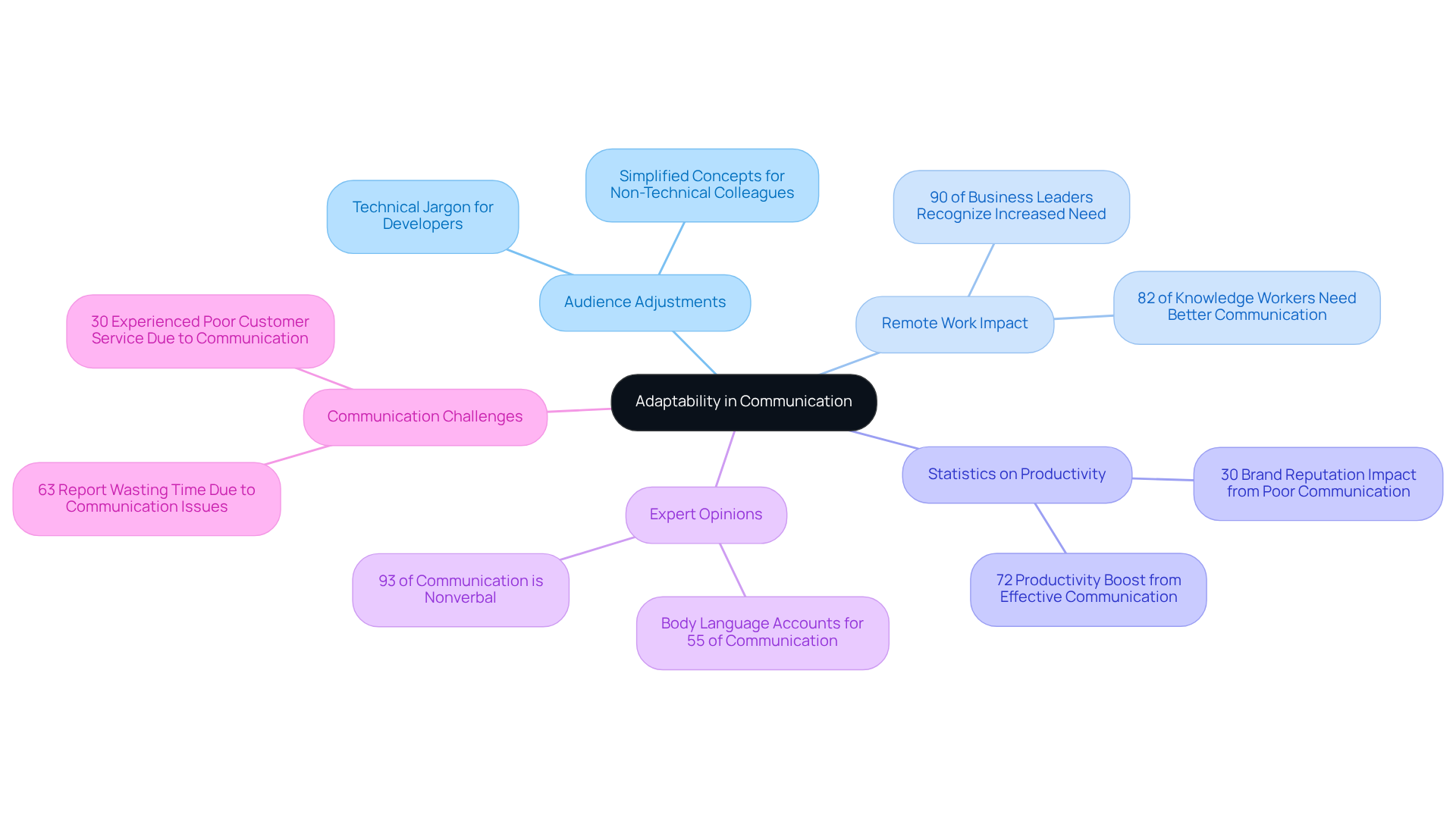
Storytelling: Inspire and Engage Your Team
Storytelling is an essential tool for founders, enabling them to communicate their vision and values effectively. By sharing personal anecdotes and success stories, leaders forge emotional connections that inspire their teams and cultivate a sense of belonging. This emotional resonance not only boosts group engagement but also fosters commitment, driving motivation and productivity within the startup environment.
Consider this: brands that harness compelling narratives witness a remarkable 20% increase in customer loyalty, exemplifying the profound impact of storytelling on engagement. Moreover, research reveals that individuals are 22 times more likely to remember a fact presented in a story compared to non-narrative information, emphasizing the critical role of narrative in creating memorable messages. Additionally, studies indicate that people forget more than 40% of the information shared with them by the following day, highlighting the necessity of storytelling for retaining key messages.
Leaders who embrace storytelling can craft relatable narratives that resonate with team members, ultimately enhancing collaboration and propelling collective action toward shared objectives. By integrating storytelling techniques into their communication techniques, founders can inspire their teams, foster a culture of openness, and significantly elevate overall performance. Furthermore, storytelling can facilitate conflict resolution by nurturing empathy and understanding among team members, reinforcing its importance in effective leadership.
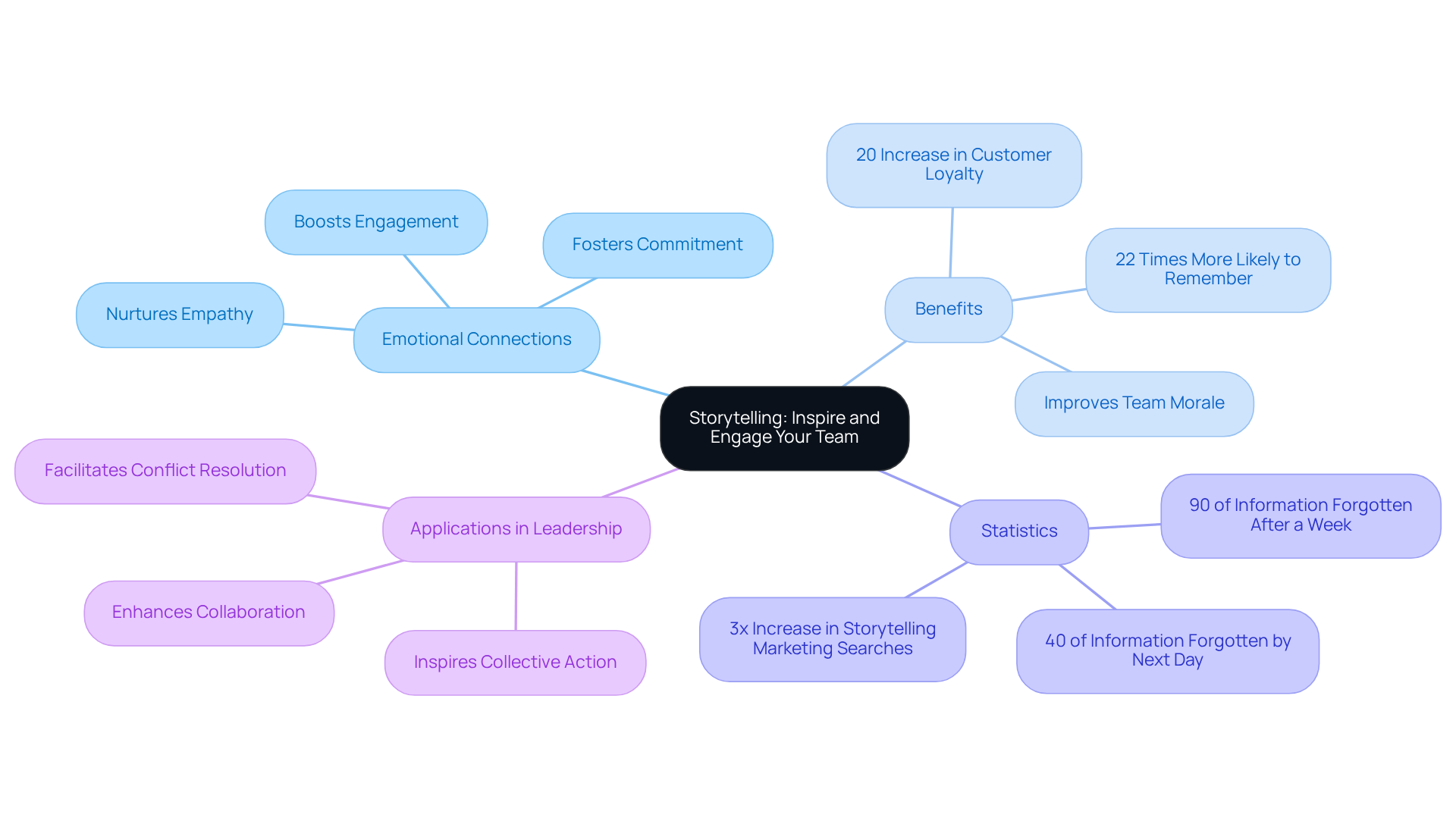
Conflict Resolution: Maintain Team Harmony and Productivity
Founders must prioritize conflict resolution by using communication techniques to understand the root causes and foster an environment of open dialogue. How can encouraging group members to express their concerns and actively listening to their perspectives lead to constructive resolutions? By addressing conflicts swiftly and justly, founders can maintain group harmony and ensure high productivity.
Research shows that 90% of relationship issues stem from misunderstandings, underscoring the critical need for effective communication techniques. Furthermore, when conflicts are viewed as opportunities for growth, they can transform challenges into catalysts for innovation. Conflict, approached with the right mindset, can be a powerful driver of personal and team development.
Startups that effectively manage conflicts often experience improved morale and collaboration, ultimately propelling their success. Effective conflict management is not just a skill; it is a key leadership competency for entrepreneurs that directly influences business success.
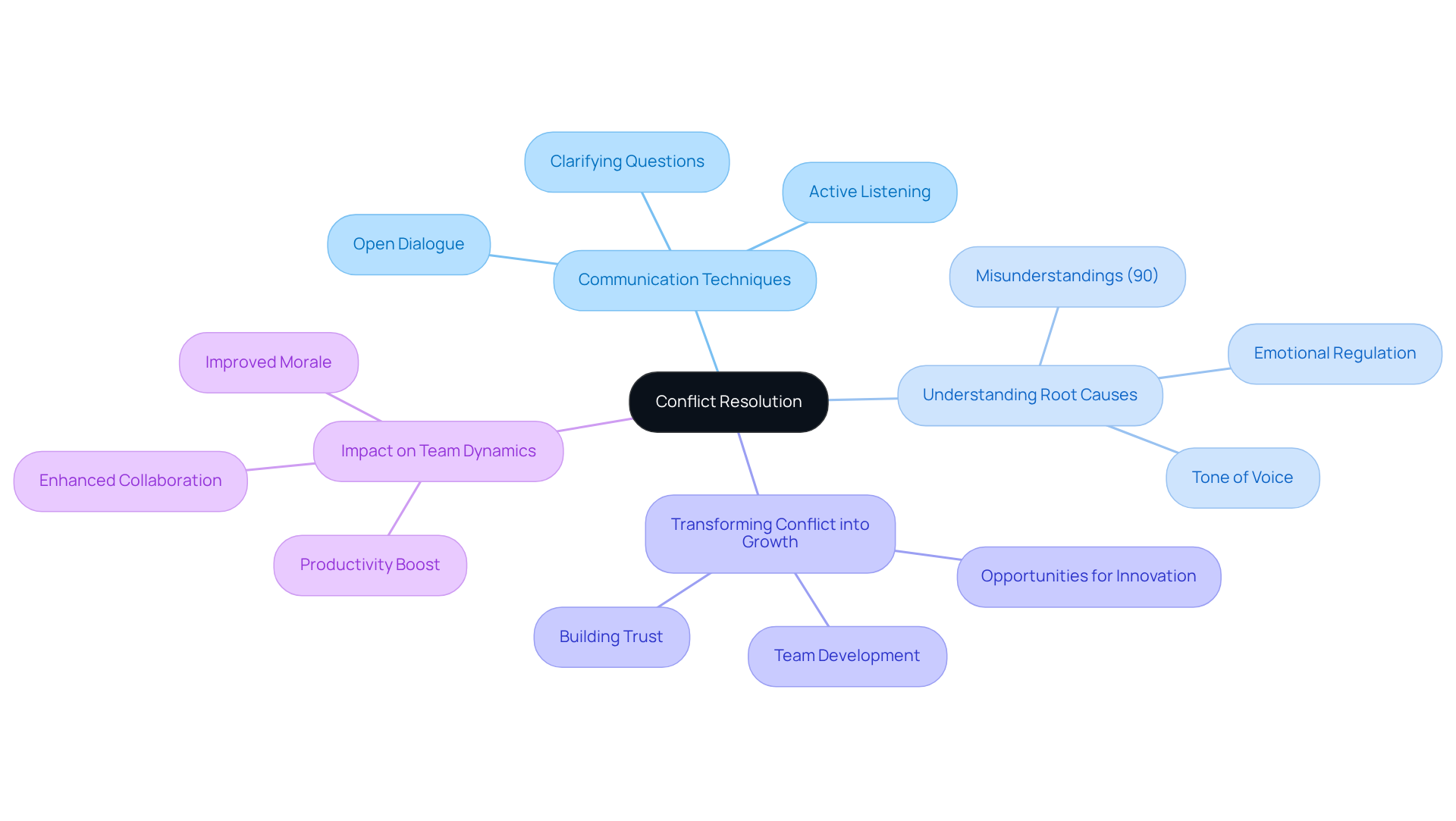
Networking: Build Relationships for Growth and Collaboration
Networking is crucial for new business creators. It involves developing and fostering connections with professionals, prospective partners, and industry leaders. Actively seeking opportunities to connect—whether through industry events, online platforms like LinkedIn, or informal meetups—can significantly enhance an entrepreneur's access to valuable resources and insights. Did you know that 85% of jobs are filled through personal connections? This statistic underscores the critical role of networking in job acquisition. By nurturing these connections, founders can unlock collaboration opportunities that propel their business's growth.
Moreover, studies show that 70% of jobs are never publicly advertised, making networking a critical avenue for discovering hidden opportunities. Participating in networking efforts not only builds trust but also increases the chances of obtaining collaborations that can advance a new business. Successful networking can lead to tangible outcomes; for example, 66% of event planners find their next client through networking at industry conferences. Thus, prioritizing networking is not just beneficial but essential for startup success.

Conclusion
Effective communication stands as a cornerstone for startup founders who aspire to cultivate successful teams and drive innovation. By mastering techniques such as:
- Task automation with tools like Casy
- Active listening
- Clarity in messaging
- Empathy
- Constructive feedback
- Nonverbal cues
- Adaptability
- Storytelling
- Conflict resolution
- Networking
entrepreneurs can significantly enhance their leadership capabilities. Each of these strategies contributes to a cohesive work environment where collaboration flourishes, ideas thrive, and productivity soars.
Throughout this article, key insights have been highlighted, demonstrating how these communication techniques can transform startups. From automating task management to fostering a culture of active listening, each method plays a vital role in aligning team members with the company's vision and objectives. Furthermore, the significance of empathy and constructive feedback cannot be overstated, as they are essential for nurturing relationships and driving continuous improvement. Nonverbal communication and adaptability also serve as crucial elements, ensuring that messages resonate with diverse audiences.
In light of the insights shared, it is imperative for startup founders to prioritize these communication techniques as they lay the foundation for a thriving organizational culture. Embracing these practices not only enhances team dynamics but also positions startups for long-term success in a competitive landscape. By taking actionable steps to implement these strategies, founders can inspire their teams, foster collaboration, and ultimately achieve their business goals.
Frequently Asked Questions
What is Casy and how does it enhance task management?
Casy is an automated project management tool that integrates with chat platforms like Slack and Telegram to automate task creation and updates. It captures essential information without manual input, allowing team members to focus on their core activities and boosting overall productivity.
How does Casy organize tasks?
Casy organizes tasks into clear categories such as R&D, Bugs, and In Progress. This structured approach improves collaboration and helps teams maintain focus on innovation and development.
What are the benefits of active listening in a business context?
Active listening enhances collaboration and productivity by up to 25% and can improve sales performance by 8%. It fosters trust and encourages teamwork, which are essential for effective innovation and problem-solving.
How can active listening impact employee satisfaction?
Training managers in active listening has been shown to result in a 30% increase in employee satisfaction, leading to higher retention rates and a more engaged workforce.
What are some effective communication techniques for new business founders?
Effective communication techniques include actively engaging group members, asking clarifying questions, reflecting on what has been expressed, and employing frequent paraphrasing to enhance understanding.
Why is clear and concise communication important for startups?
Clear and concise communication helps align team members with the company's objectives, fosters a shared understanding, and minimizes confusion, enabling effective collaboration toward common goals.
What statistics highlight the importance of effective communication in businesses?
96% of individuals believe effective communication is vital for businesses, and 35% of individuals feel that the firms they collaborate with have improved their communication over the past year.
How can tools like Casy contribute to team alignment?
Casy can streamline communication processes and enhance team alignment by facilitating clearer task management and ensuring that all team members are on the same page regarding objectives and expectations.




